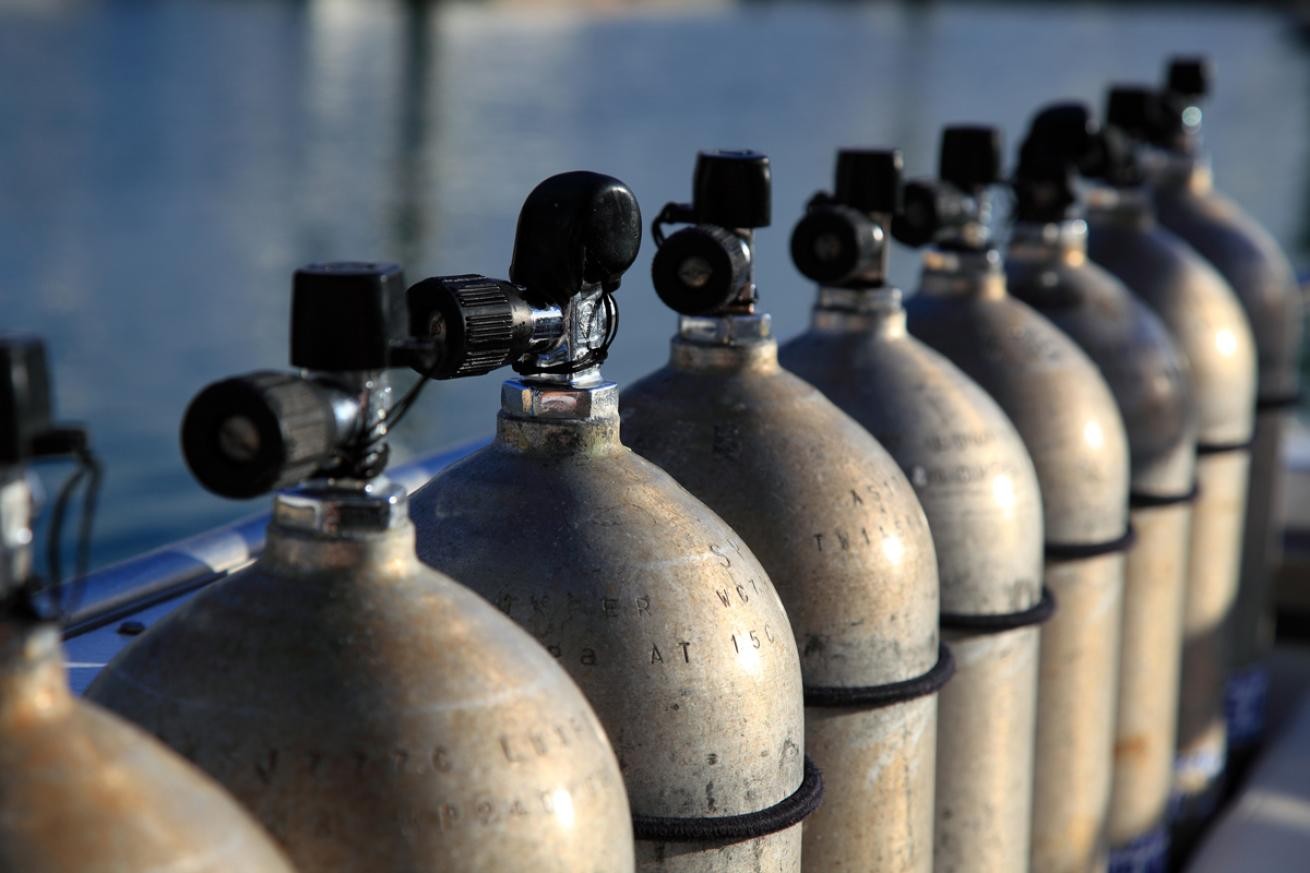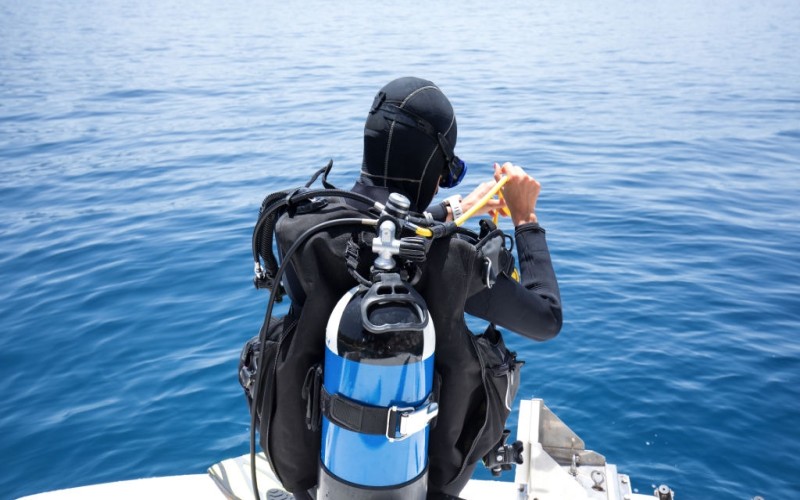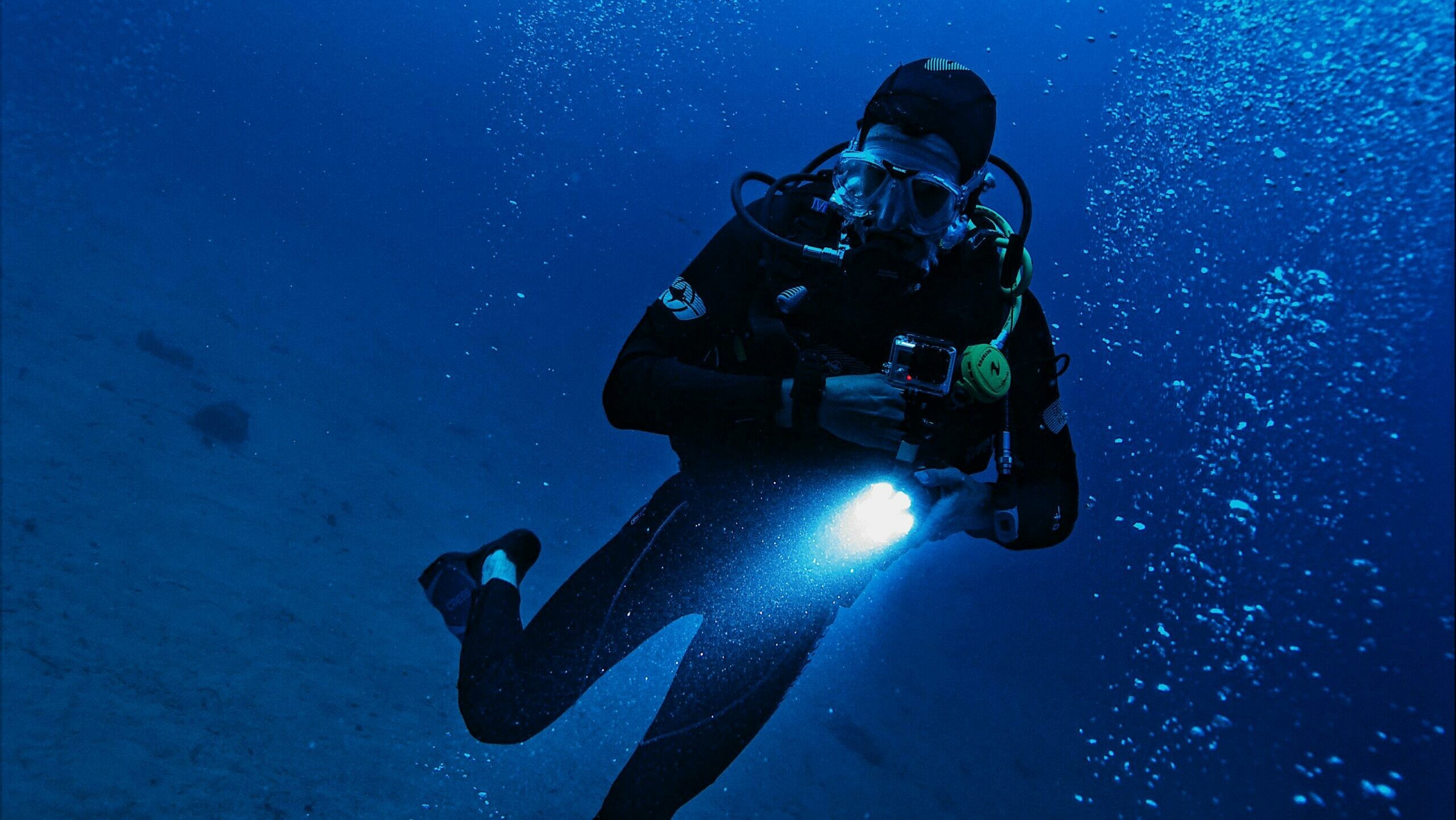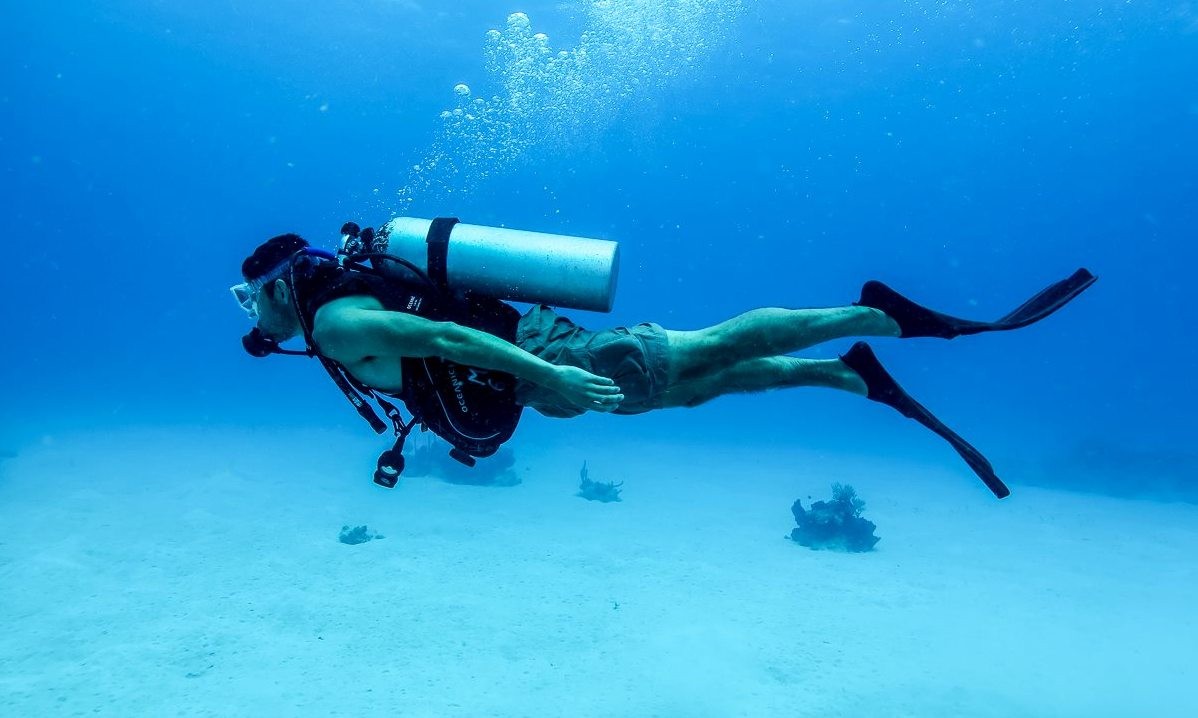Diving Sites in Port Blair




-
Jul 28, 2025
Scuba Diving Cylinders
Want to experience the underwater world with confidence? Read how to select the correct dive cylinder for your diving needs with the tips from Dive Andaman. Choosing the correct dive cylinder is a vital step in preparing to have a safe and enjoyable scuba dive. Dive cylinders, or scuba tanks, will be your main source of air under the water. Choosing the correct dive cylinder will affect your buoyancy in the water, durability, comfort, and much more. Whether a new diver or an advanced diver considering a dive cylinder, knowing about the differences in dive cylinder types, sizes, and materials will help you make a better informed decision.
At Dive Andaman, we've guided divers every step of the way including choosing scuba gear so they can dive safely and confidently in the stunning waters of the Andaman Islands. Your scuba tank isn’t just a piece of kit, it is your lifeline underwater. With the right cylinder, you can maximize your air consumption, allow yourself buoyancy control, and even improve your comfort whilst diving. If your tank is too heavy, buoyant, or runs out of air too quickly, your diving experience may be curtailed unnecessarily or unduly difficult. This is why selecting the right cylinder is an important part of your scuba preparation, especially when you are going to be diving in variable water conditions like those around Havelock Island, Neil Island, or North Bay where Dive Andaman operates.
Types of Scuba Diving Cylinders:
- Aluminum Cylinder
- Steel Cylinder
- High-Pressure (HP) Cylinder
- Low-Pressure (LP) Cylinder
- Standard Pressure Cylinder
- DIN Valve Cylinder
- Yoke Valve (A-Clamp) Cylinder
- Nitrox Cylinder
- Trimix Cylinder
- Heliox Cylinder
- Pony Bottle
- Sidemount Cylinder
- Twin Set / Doubles Cylinder
- Stage / Deco Cylinder
- Bailout Cylinder
Why Does the Right Dive Cylinder Matters?

As you are dreaming about scuba diving, your mind likely goes to the blue water, awesome coral reefs, and the beautiful silence that comes with being underwater. However, one important and largely ignored piece of diving equipment, your dive cylinder or scuba tank, plays an actual central role in each successful and safe dive.
There are tended to be advances when you have services in flight for things into view and passion and aspirations of adventure is the thing with a fellow diver you get the interest and purchase to remember something you already know too "a correctly fitted diving cylinder when matched to your body, rank and, diving work, let's be honest when thinking about things here, are not the same". Now I would say: not one thing is the same! If you tube choose a tank too big for your effort, you feel as if you are always off balance, seems like you are adding weight and if I could deliver a final blow, wind up without air too soon and have curtailed the dive and then on the deep air based rise getting diver styled bent balloon.
It’s Not One-Size-Fits-All:
As they say, just like no two divers are alike, no one single dive cylinder is the great match for everybody. Some divers need more bottom time and are willing to carry a little extra weight. Others really want lighter gear, especially if flying halfway around the world to dive. If you are a beginner diver, the most common tank is an 80-cubic-ft aluminum tank. If you are an experienced diver, or a technical diver, you may prefer a high-pressure steel tank that has better buoyancy characteristics. This is where some personal differences come into play. The important thing about tanks is to look at what you need and what your dive style is, but also to consider your own physical comfort level. Generally speaking, a larger tank will provide more air, and that much more air also weighs more. A lighter tank is easier to manage, but it may also limit your time on a dive. It's a trade-off. The right choice to be made is the one that allows you to feel balanced, relaxed and secure.
Comfort and Buoyancy Go Hand in Hand:
Comfort underwater doesn't just pertain to the fit of your wetsuit or how tight your mask is, but also how well your tank interacts with your body. If your tank is overly buoyant, or too heavy, that affects your posture in the water. Buoyancy control is ultimately what allows you to glide effortlessly, stay off the reef, and conserve energy. If you have the 'wrong' tank, that can make buoyancy control more difficult, and require you to compensate with additional weight. For example, aluminum tanks are common and reliable, however they will take on positive buoyancy as they empty, and divers will often need to compensate with additional weights. Steel tanks tend to remain negative throughout, and can also help you maintain more balance but are typically heavier above the water line. It's not that one is overall 'better', it's that one may be better for you.
Air Consumption and Dive Confidence:
Another significant consideration? Air supply. The capacity and the pressure rating of your dive cylinder determine how much air you have and how long you can rely on it. If you are someone who tends to breathe slightly above the average breathing rate (which many new divers do), then having the benefit of a larger tank or tank with a higher pressure may give you longer underwater times and lessen the anxiety of air consumption. Feeling confident in your air supply allows you to feel relaxed, focused on your dive, and enjoy the beauty around you without having to check your pressure gauge every few minutes. This happens at Dive Andaman every day: the moment a diver gets their gear set up correctly their entire diving experience changes! Movement is more fluid, their breathing slows down, and they are having a better time overall. This is exactly why we take the time to explain equipment to our students and guests, not just how to use it, but how to make the best gear choices.
It’s Part of Your Dive Journey:
Choosing the right dive cylinder is part of becoming a confident, capable diver. It is not a purely technical decision; rather it is a deeply personal decision that develops throughout your time diving. Every time you dive in new conditions, chances are you'll find out what suits you best, whether it be warm, shallow water, drift diving, or diving into the deep blue. When you dive with us at Dive Andaman, we do not give you a tank and send you off to the deep. We take the time to go through every component, we explain different tank behaviour underwater, we let you try different configurations so you can feel the difference, and ultimately we help you understand how diving cylinders affect your dive. This way, you don't just become a diver, you become an underwater explorer; aware of the gear you are using, aware of your surroundings, and aware of yourself.
How to Identify Different Types of Scuba Diving Cylinders?
Selecting and identifying the different types of scuba diving cylinders is an essential skill for safety and comfort, and overall diving experience. As a diver, knowledge of different tank types, materials, and specifications helps to choose the proper cylinder for your diving style and environment. Whether you are preparing for your first dive, or are stopped in your tracks as you build upon your technical diving experiences, here is a full rundown of how to identify scuba diving cylinders.
1. Material: Aluminum vs. Steel Cylinders
One of the easiest ways to differentiate scuba tanks is by the material they’re made from.
Aluminum Cylinders
- Appearance: Often have a dull silver or painted finish, sometimes thicker walls.
- Buoyancy: Tend to become positively buoyant as air is consumed.
- Weight: Slightly heavier on land compared to similar-capacity steel tanks.
- Use: Most common in recreational diving, especially at tropical resorts and dive schools.
- Markings: Look for “AL” or “Aluminum” on the neck or body.
Steel Cylinders
- Appearance: Usually slimmer with a polished or painted finish.
- Buoyancy: Stay negatively or neutrally buoyant throughout the dive.
- Weight: Heavier than aluminum when full but may require less additional weight due to buoyancy properties.
- Use: Preferred in cold water, technical diving, or dives requiring better buoyancy control.
- Markings: Look for “ST”, “Steel”, or brand-specific steel labeling.
2. Size and Capacity
Scuba tanks come in different sizes and capacities, typically measured in cubic feet (imperial) or liters (metric). Here’s how to identify them:
Common Sizes:
- Aluminum 80 (11.1 liters): The standard for recreational divers. Often labeled as “AL80”.
- Aluminum 63, 100, 120: Used for smaller or longer dives.
- Steel 100, 117, 120: Larger capacity with better buoyancy for extended or deeper dives.
How to Identify:
- Capacity is usually stamped on the tank neck or shoulder.
- Example: “3AL 3000” – this means the cylinder is aluminum, with a working pressure of 3000 PSI.
- In metric tanks, you might see “12L 230 BAR”.
3. Pressure Ratings
Scuba cylinders are designed to hold compressed gas at high pressure. They are labeled with their working pressure and sometimes test pressure.
- Low Pressure (LP): Around 2400–2640 PSI (165–182 bar).
- Standard Pressure: Around 3000 PSI (200–207 bar) – most common for aluminum tanks.
- High Pressure (HP): Up to 3442–3500 PSI (230–240 bar) – more common in steel tanks.
How to Identify:
Look for stamped markings like:
- “3000 PSI” or “207 BAR”
- “HP100” = High-pressure 100 cubic feet
- “LP72” = Low-pressure 72 cubic feet
4. Valve Types
The cylinder valve controls airflow and must match your regulator type. There are two main types:
Yoke (A-Clamp) Valve
- More common in recreational diving
- Easily identified by a flat valve surface
- Compatible with most standard rental gear
DIN Valve
- Has a threaded opening; the regulator screws into the valve
- Used in technical diving and high-pressure tanks
- Offers a more secure connection at higher pressures
Some tanks have convertible valves, which can switch between DIN and yoke using an insert. You can usually spot these by the removable insert in the valve opening.
5. Color Coding and Labels (May Vary by Region)
While not globally standardized, some dive centers use color codes or tank wraps to indicate gas type or tank contents:
- Air: Typically not labeled or has a white/black label
- Nitrox (Enriched Air): Often has a green and yellow label
- Trimix or Technical Gases: Clearly labeled due to oxygen/helium mixes
6. Markings to Look For
Each cylinder has stamped markings near the neck that reveal important specifications:
- Manufacturer and Serial Number
- Material Code (e.g., 3AL for aluminum)
- Working Pressure (e.g., 3000 PSI or 207 BAR)
- Hydrostatic Test Date
- Capacity in liters or cubic feet
Example:
DOT-3AL 3000 80CUFT 06/23
This means:
- Aluminum tank
- Working pressure 3000 PSI
- 80 cubic feet capacity
- Hydro tested in June 2023
Tips from Dive Andaman
- If you're unsure about which cylinder to use, ask your instructor or dive guide.
- Choosing the wrong type can impact your buoyancy and dive duration.
- Always check the test date and visual inspection sticker to ensure the tank is safe to use.
- Pay attention to valve type and compatibility with your regulator setup.
Key Factors to Consider When Choosing a Dive Cylinder
1. Material: Aluminum vs. Steel
- Aluminum Cylinders : Aluminum tanks are by far the most popular type of tank used in recreational diving. They are inexpensive, and they are resistant to corrosion. They are also easy to care for and maintain, with little surface corrosion issues as practically 100% of diving happens in fresh or salt water. They do have the tendency to be positively buoyant toward the end of the dive and you may be required to add even more weights to remain neutrally buoyant (and to truly finish the dive).
- Steel Cylinders : Steel tanks do have a noticeable strength and shape advantage. Steel tanks have better buoyancy characteristics than aluminum tanks (negatively buoyant even when empty), and provide better weighting distribution challenging the notion that all tanks are the same and poor weighting can pour safety problems on the diver. Steel tanks have more small pieces to maintain to prevent rusting on the inside mainly due to usage in saltwater.
2. Size and Capacity
Dive cylinders are available in different sizes, depending upon the unit of measurement, liters or cubic feet. The most common size is the 80-cubic-foot aluminum tank (this is close to 11 liters) ; this is the suitable size for most divers at a recreational level. We also have larger tanks, e.g., 100 or 120 cubic feet, with more air, meaning longer dives, but they come at the cost of more weight and bulk to carry. There are also smaller tanks that can be used for shorter dives or shallower dives. Our instructors at Dive Andaman can assist in picking the right size based on a combination of air consumption, depth and level of diving experience.
3. Pressure Rating
Diving tanks are rated based on the pressure of the compressed air they are capable of holding. Most recreational tanks are rated between 2000-3000 PSI (pounds per square inch) or 200-300 bar. High-pressure cylinders can hold more air but in more compressed space. They also require regulators that are compatible with the high pressure. Always check for compatibility of equipment prior to selecting a high-pressure tank.
4. Buoyancy and Weight Considerations
The buoyancy properties of a tank will have an affect on your ability to maintain neutral buoyancy underwater. As noted, an aluminum tank will become positively buoyant through most of the tank when the air is depleted, while a steel tank will remain negatively buoyant. Understanding the characteristics of your dive tanks should help you better manage your weighting system and help you to position yourself properly in the water
5. Valve Type – DIN or Yoke
Dive tanks typically have one of two types of valves: DIN (Deutsches Institut für Normung) and Yoke (A-clamp). DIN valves are generally more secure and popular for technical diving while yoke valves are more widely used in recreational diving. Regardless, always match your regulator to the tank valve or have an adapter for versatility.
Matching Your Dive Cylinder to the Type of Diving
At Dive Andaman, we provide high-quality, well-maintained scuba cylinders tailored to your dive plan and experience level. Our instructors ensure you're using the right equipment and teach you how to inspect and set up your gear before every dive. Different types of diving require different tank setups:
- Recreational Diving: Standard aluminum 80 tanks are ideal.
- Deep or Technical Diving: High-capacity steel tanks or twin sets are often used.
- Travel Diving: Lightweight aluminum tanks are easier to carry and available worldwide.
- Training and Short Dives: Smaller tanks are easier to handle and great for beginners.
Learn With the Experts at Dive Andaman
Whether you're preparing for your first dive or gearing up for more advanced adventures, Dive Andaman ensures you have the right equipment and knowledge to dive safely and confidently. When you dive with Dive Andaman, you're not just renting gear you’re learning from some of the best scuba professionals in India. Our team offers expert advice on choosing and using dive cylinders, as well as comprehensive training through PADI-certified courses including:
- PADI Open Water Diver Course
- Advance Open Water Course
- Rescue Diver Course
- Speciality Courses like Deep Diving and Nitrox
Choose your Scuba Diving Cylinder Wisely
Selecting the proper dive cylinder is critical if you want to maximize your scuba diving experience. Material, size, pressure rating, buoyancy, valve all factor into which dive cylinder is going to be the best fit based on your body and diving experience. Always speak with an expert if you don't know which one to choose at a dive centre you trust. Ready for a scuba diving trip to the incredible, clear blue waters of the Andaman Islands with professional support and high-quality scuba equipment? Reach out to Dive Andaman today for more details on our dive packages, scuba training programs, and scuba equipment to rent or buy. We will help you choose the right dive cylinder for your underwater adventures and make those adventures positive, fun, and memorable.
Diving Sites in Port Blair
Diving Sites in Havelock Island
Diving Sites in Neil Island

.jpg)


